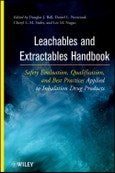A practical and science-based approach for addressing toxicological concerns related to leachables and extractables associated with inhalation drug products
Packaging and device components of Orally Inhaled and Nasal Drug Products (OINDP)such as metered dose inhalers, dry powder inhalers, and nasal sprayspose potential safety risks from leachables and extractables, chemicals that can be released or migrate from these components into the drug product. Addressing the concepts, background, historical use, and development of safety thresholds and their utility for qualifying leachables and extractables in OINDP, the Leachables and Extractables Handbook takes a practical approach to familiarize readers with the recent recommendations for safety and risk assessment established through a joint effort of scientists from the FDA, academia, and industry. Coverage includes best practices for the chemical evaluation and management of leachables and extractables throughout the pharmaceutical product life cycle, as well as:
-
Guidance for pharmaceutical professionals to qualify and risk-assess container closure system leachables and extractables in drug products
-
Principles for defining toxicological safety thresholds that are applicable to OINDP and potentially applicable to other drug products
-
Regulatory perspectives, along with an appendix of key terms and definitions, case studies, and sample protocols
Analytical chemists, packaging and device engineers, formulation development scientists, component suppliers, regulatory affairs specialists, and toxicologists will all benefit from the wealth of information offered in this important text.
Table of Contents
Acknowledgements.Dedication.
Preface.
Part I. Development of Safety Thresholds, Safety Evaluation, and Qualification of Extractables and Leachable in Orally Inhaled Nasal Drug Products.
1. Chapter 1. Overview of Leachables and Extractables in Orally Inhaled and Nasal Products (Douglas J. Ball, Daniel L. Norwood, Lee M. Nagao).
2. Chapter 2. A General Overview of the Suitability for Intended Use Requirements for Materials Used in Pharmaceutical Systems (Dennis Jenke).
3. Chapter 3. Concepts and Application of Safety Thresholds in Drug Development (David Jacobson-Kram and Ronald D. Snyder).
4. Chapter 4. The Development of Safety Thresholds for Leachables on Orally Inhaled and Nasal Drug Products (W. Mark Vogel).
5. Chapter 5. The Analytical Evaluation Thresholds (AET) and its Relationship to Safety Thresholds (Daniel L. Norwood, James O. Mullis, Scott Pennino).
6. Chapter 6. Safety Thresholds in the Pharmaceutical Development Process for OINDP: An Industry Perspective (David Alexander and James Blanchard).
7. Chapter 7. The Chemistry and Toxicology Partnership: Extractables and Leachables Information Sharing Among the Chemists and Toxicologists (Cheryl L. M. Stults, Ronald Wolff, Douglas J. Ball).
8. Chapter 8. Use of Safety Thresolds in the Pharmaceutical Development Process for OINDP: US Regulatory Perspectives (Timothy J. McGovern).
9. Chapter 9. The Application of Safety Thresholds to Quality Leachables from Plastic Container Closure Systems Intended for Pharmaceutical Products: A Regulatory Perspective (Kumudini Nicholas).
Part 2. Best Practices for Evaluation and Management of Extractables and Leachables in Orally Inhaled and Nasal Drug Products.
10. Chapter 10. Analytical Best Practices for the Evaluation and Management of Extractables and Leachables in Orally Inhaled and Nasal Drug Products (Dan Norwood, Cheryl Stults and Lee Nagao).
11. Chapter 11. Chemical and Physical Attributes of Plastics and Elastomers: Impact on the Extractables Profile of Container Closure Systems (Michael A Ruberto and Diane Paskiet).
12. Chapter 12. Pharmaceutical Container Closure System – Selection & Qualification of Materials (Douglas J. Ball, William P. Beierschmitt, and Arthur J. Shaw).
13. Chapter 13. Analytical Techniques for Identification of Extractables and Leachables (Dan Norwood, Thomas N. Feinberg, James O. Mullis, and Scott Pennino).
14. Chapter 14. Extractables – The Controlled Extraction Study (Thomas N. Feinberg, Daniel L. Norwood, Alice T. Granger, and Dennis Jenke).
15. Chapter 15. Extractables – Case Study of a Sulfur Elastomer (Daniel L. Norwood, Fenghe Qiu, James Coleman, James O. Mullis, Alice T. Granger, Keith McKellop, Michelle Raikes, John Robson, David Olenski, John Hand, Sr., Melinda K. Munos, Tianjing Deng, Xiaochun Yu, Derek Wood, Shauang Li, Song Klapoetke and Xiaoya Ding).
16. Chapter 16. Extractables – Case Study of a Polypropylene (Diane Paskiet, Laura Stubbs, and Alan D. Hendricker).
17. Chapter 17. Leachables – Analytical Leachables Studies (Andrew D. Feilden and Andy Rignall).
18. Chapter 18. Development and Optimization of Methods for Routine Testing (Cheryl L. Stults and Jason M. Creasey).
19. Chapter 19. Critical Component Quality Control and Specification Strategies (Terrence Tougas, Suzette Roan, and Barbara Falco).
20. Chapter 20. Inorganic Leachables (Diane Paskiet, Ernest L. Lippert, Brian D. Mitchell, and Diego Zurbriggen).
21. Chapter 21. Foreign Particulate Matter (James Coleman, John A. Robson, John A. Smoliga, and Cornelia B. Field).








